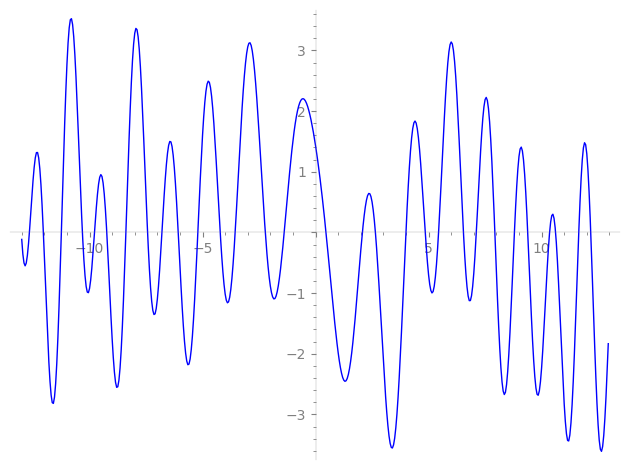| L(s) = 1 | + 5-s + (1.5 − 2.59i)9-s + (1 + 1.73i)11-s + (−3.5 + 0.866i)13-s + (−1.5 + 2.59i)17-s + (−3 + 5.19i)19-s + (2 + 3.46i)23-s − 4·25-s + (3.5 + 6.06i)29-s − 4·31-s + (−4.5 − 7.79i)37-s + (4.5 + 7.79i)41-s + (−5 + 8.66i)43-s + (1.5 − 2.59i)45-s + 2·47-s + ⋯ |
| L(s) = 1 | + 0.447·5-s + (0.5 − 0.866i)9-s + (0.301 + 0.522i)11-s + (−0.970 + 0.240i)13-s + (−0.363 + 0.630i)17-s + (−0.688 + 1.19i)19-s + (0.417 + 0.722i)23-s − 0.800·25-s + (0.649 + 1.12i)29-s − 0.718·31-s + (−0.739 − 1.28i)37-s + (0.702 + 1.21i)41-s + (−0.762 + 1.32i)43-s + (0.223 − 0.387i)45-s + 0.291·47-s + ⋯ |
Λ(s)=(=(2548s/2ΓC(s)L(s)(0.0128−0.999i)Λ(2−s)
Λ(s)=(=(2548s/2ΓC(s+1/2)L(s)(0.0128−0.999i)Λ(1−s)
| Degree: |
2 |
| Conductor: |
2548
= 22⋅72⋅13
|
| Sign: |
0.0128−0.999i
|
| Analytic conductor: |
20.3458 |
| Root analytic conductor: |
4.51064 |
| Motivic weight: |
1 |
| Rational: |
no |
| Arithmetic: |
yes |
| Character: |
χ2548(393,⋅)
|
| Primitive: |
yes
|
| Self-dual: |
no
|
| Analytic rank: |
0
|
| Selberg data: |
(2, 2548, ( :1/2), 0.0128−0.999i)
|
Particular Values
| L(1) |
≈ |
1.428628038 |
| L(21) |
≈ |
1.428628038 |
| L(23) |
|
not available |
| L(1) |
|
not available |
L(s)=p∏Fp(p−s)−1 | p | Fp(T) |
|---|
| bad | 2 | 1 |
| 7 | 1 |
| 13 | 1+(3.5−0.866i)T |
| good | 3 | 1+(−1.5+2.59i)T2 |
| 5 | 1−T+5T2 |
| 11 | 1+(−1−1.73i)T+(−5.5+9.52i)T2 |
| 17 | 1+(1.5−2.59i)T+(−8.5−14.7i)T2 |
| 19 | 1+(3−5.19i)T+(−9.5−16.4i)T2 |
| 23 | 1+(−2−3.46i)T+(−11.5+19.9i)T2 |
| 29 | 1+(−3.5−6.06i)T+(−14.5+25.1i)T2 |
| 31 | 1+4T+31T2 |
| 37 | 1+(4.5+7.79i)T+(−18.5+32.0i)T2 |
| 41 | 1+(−4.5−7.79i)T+(−20.5+35.5i)T2 |
| 43 | 1+(5−8.66i)T+(−21.5−37.2i)T2 |
| 47 | 1−2T+47T2 |
| 53 | 1−9T+53T2 |
| 59 | 1+(−7+12.1i)T+(−29.5−51.0i)T2 |
| 61 | 1+(2.5−4.33i)T+(−30.5−52.8i)T2 |
| 67 | 1+(−4−6.92i)T+(−33.5+58.0i)T2 |
| 71 | 1+(5−8.66i)T+(−35.5−61.4i)T2 |
| 73 | 1−7T+73T2 |
| 79 | 1−2T+79T2 |
| 83 | 1−6T+83T2 |
| 89 | 1+(−3−5.19i)T+(−44.5+77.0i)T2 |
| 97 | 1+(−1+1.73i)T+(−48.5−84.0i)T2 |
| show more | |
| show less | |
L(s)=p∏ j=1∏2(1−αj,pp−s)−1
Imaginary part of the first few zeros on the critical line
−9.237345327956482721394767972710, −8.392251054166184215278769066262, −7.43196520287299727545806214717, −6.79723032020176407291172815408, −6.07640451188673910534696769876, −5.20859730866804991322825135776, −4.21834833239435695751417974752, −3.55765056546726034712774659494, −2.22336974564856587144707062007, −1.38768714962326992062310427925,
0.46032145690407628496447076092, 2.07222224257763937184449827180, 2.64698627841450364886970071717, 3.99833159966872107770044250378, 4.85239784626783516568776957328, 5.44206600500674848502534607058, 6.54261187815172419624591523247, 7.11196513489318938581663957820, 7.931956435518194900755251474421, 8.797434169369425914973336238245

